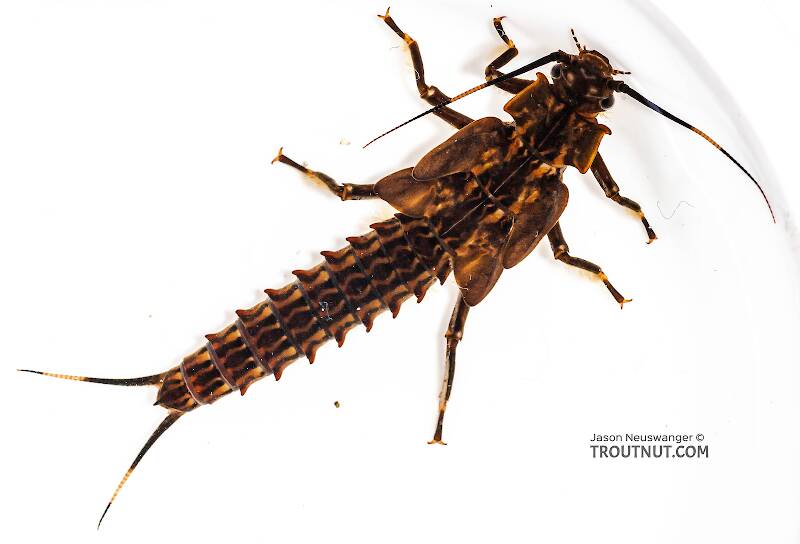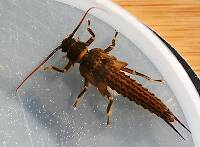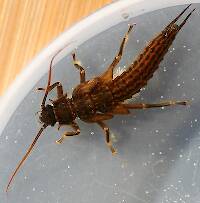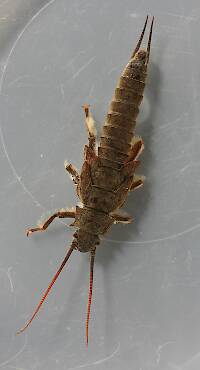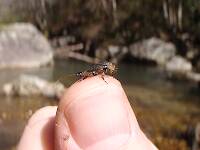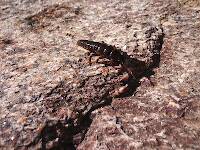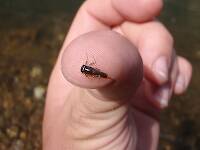
Hex Mayflies
Hexagenia limbata
The famous nocturnal Hex hatch of the Midwest (and a few other lucky locations) stirs to the surface mythically large brown trout that only touch streamers for the rest of the year.
Featured on the forum

Troutnut is a project started in 2003 by salmonid ecologist Jason "Troutnut" Neuswanger to help anglers and
fly tyers unabashedly embrace the entomological side of the sport. Learn more about Troutnut or
support the project for an enhanced experience here.
Beardius
Posts: 19
Posts: 19
Beardius on Aug 1, 2008August 1st, 2008, 8:53 am EDT
Pteronarcys proteus has abdominal knobs but has a squared off pronotum (no projection of knob). It differs from dorsata in having knobs on the abdominal segments. There is a picture of a young Pteronarcys proteus nymph here: http://www.discoverlife.org/mp/20q?search=Pteronarcys+proteus
Pteronarcys comstocki has pronotal projections and a spine-like projection on the anterior mesonotal wingpad. I only found them in one stream (trib of Kettle Creek in central PA) of the dozens I've collected. I have not collected them in MD, but they are reported from WV and PA. There is a photo of an immature nymph here: http://www.discoverlife.org/mp/20o?search=Pteronarcys+comstocki
Pteronarcys biloba has pronotal projections but no spines on the wingpads. P. biloba is common up north (NY, VT, NH, ME, etc.). The photo above is of P. biloba. Nice photo here: http://www.discoverlife.org/mp/20q?search=Pteronarcys+biloba
P. scotti is found in the south (SC,GA, etc.)
I never collected P. dorsata, so I figure it must be in larger or warmer rivers.
Pteronarcys comstocki has pronotal projections and a spine-like projection on the anterior mesonotal wingpad. I only found them in one stream (trib of Kettle Creek in central PA) of the dozens I've collected. I have not collected them in MD, but they are reported from WV and PA. There is a photo of an immature nymph here: http://www.discoverlife.org/mp/20o?search=Pteronarcys+comstocki
Pteronarcys biloba has pronotal projections but no spines on the wingpads. P. biloba is common up north (NY, VT, NH, ME, etc.). The photo above is of P. biloba. Nice photo here: http://www.discoverlife.org/mp/20q?search=Pteronarcys+biloba
P. scotti is found in the south (SC,GA, etc.)
I never collected P. dorsata, so I figure it must be in larger or warmer rivers.
GONZO on Oct 28, 2008October 28th, 2008, 7:51 am EDT
I just noticed that this thread was an answer to questions that I raised some time ago in the related thread. Beardius' comments and the links to photos and identifications done by Donald Chandler (Dsc1) are very helpful.
It is now easier to see that this is biloba and that the other specimen (#490) is probably proteus. In addition to the traits that Beardius mentions, the abdominal knob seems to dramatically diminish or disappear after the 7th segment in proteus, but biloba usually has a prominent knob on segment 8. I really don't know how reliable this is, but it seems to be consistent in all of the specimens I have seen.
It is now easier to see that this is biloba and that the other specimen (#490) is probably proteus. In addition to the traits that Beardius mentions, the abdominal knob seems to dramatically diminish or disappear after the 7th segment in proteus, but biloba usually has a prominent knob on segment 8. I really don't know how reliable this is, but it seems to be consistent in all of the specimens I have seen.
Quick Reply
Related Discussions
Topic
Replies
Last Reply
0
May 19, 2007
by GONZO
by GONZO
4
Sep 4, 2012
by Entoman
by Entoman
3
Oct 4, 2006
by GONZO
by GONZO
1
Aug 1, 2008
by Troutnut
by Troutnut
3
Apr 26, 2010
by RyanBednar
by RyanBednar
2
Feb 6, 2017
by Crepuscular
by Crepuscular



